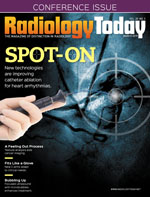 Editor’s Note: On Target
Editor’s Note: On Target
By Dave Yeager
Radiology Today
Vol. 20 No. 3 P. 3
Precision is an ongoing goal in health care. It has expanded practitioners’ store of knowledge, enabled new treatments, and, often, improved outcomes. To that end, this month’s issue deals with treatments and technologies that are hitting the mark better than ever before.
Our cover feature highlights the use of catheter ablation for atrial fibrillation, which is affecting an increasing number of people in the United States. Although usually not fatal on its own, atrial fibrillation can increase the risk of heart attack or stroke. Catheter ablation is becoming a frontline treatment, and Beth W. Orenstein reports on advances that are moving the technology forward. New methods of mapping blood vessels and identifying optimal ablation sites are helping to improve its accuracy and efficacy.
Of course, optimized treatment can be greatly assisted by optimized imaging. Pamela Q. Fernandes, MD, takes a look at texture analysis, which identifies quantitative patterns in the pixels of cancer lesion images. Fernandes attended Memorial Sloan Kettering Cancer Center’s Pancreas Cancer Symposium last fall, and she interviewed an expert in the field. Texture imaging and analysis show promise for helping clinicians predict how a patient is likely to respond to various treatment protocols. Although the technology needs to be standardized before it can be widely used, it holds great potential.
Next, Keith Loria rounds up the latest advances in C-arms. These imaging tools are invaluable for many surgical applications, and vendors are working to increase their versatility and mobility while reducing radiation dose. Loria checks in with manufacturers to find out what upgrades they’ve made and where they see the industry going.
Finally, another technology with the potential to deliver optimized treatment is focused ultrasound. Kathy Hardy speaks with some researchers who are using focused ultrasound with microbubbles to penetrate the blood-brain barrier and deliver medication more accurately and potently. Although the blood-brain barrier offers important protection from bacteria, viruses, and other toxins, it makes delivery of therapeutic drugs highly challenging. The researchers hope that the technique will allow previously ruled-out drugs for conditions such as Alzheimer’s disease, Parkinson’s disease, and cancer to be reevaluated in light of being delivered more precisely and in higher concentrations than were previously possible. In the case of Alzheimer’s, some research even suggests that focused ultrasound alone has a therapeutic effect.
Enjoy the issue.
david.yeager@gvpub.com

